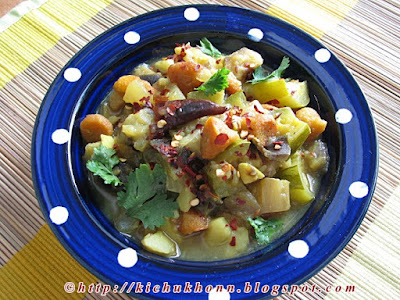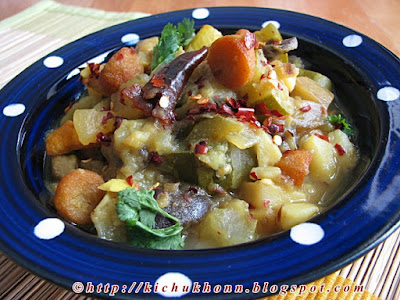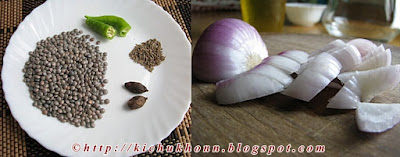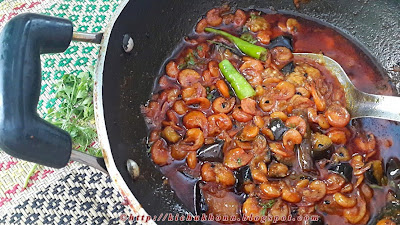I just can't have enough of the rains.
Ever.
Last week it had rained non stop for three to four days. With dark clouds, heavy wind and fog.
Pune's rains are like quiet children.
They will be around yet you won't feel their presence. Calm, quiet, a little shy and not at all noisy or rude.
So unless you are in the vicinity of a window or the outdoors, most of the time you won't even know it is raining. And in the earnest, too.
So every time I knew it was raining, I would drop everything and rush to the windows.
We have huge bay windows and even the slightest opening is enough to drive the heavy wind inside, resulting in papers, pens, glasses and other things flying off the dining table and whirling around in the rest of the house.
And god help me if there is a newspaper around.
Still, nothing could stop me from opening the window ... even a wee little bit ... and smell the wet air deep. The smell of rain and fresh, wet leaves and the earth and grass ... everything reaches deep into me and my soul.
Such freshness!
Such peace!
Now we are back to cheerful, sunny days, though there are clouds hovering in the horizon.
Very soon, they will come over. And stay for a while.
And I can spend more time near my windows. Yes, I have even moved a sofa to be real near.
To be able to feel the spray on my face .
And let the cold wind take my breath away.
My poncho is almost done. Hopefully I will be able to snuggle into it too.
And my favourite writer's latest book is at hand. I am saving it for the rains.
Yes, I can be patient.
I don't know about the rest of the country, but rains in Pune means cold weather.
And with the temperature almost nearing 17 degrees, to me it is very, very cold weather.
Which reads, along with the Bengali favourite Khichudi, blankets, shawls and sometimes the heater too.
And Pithe.
Or Pithas. The Odiya pithas. Mostly the savoury ones.
And some garam garam, light, soupy Santula to go with them.
Growing up in Orissa / Odisha meant being familiar to Odiya food as much as I am familiar to Bengali food. And the Oriya lady who stayed with us and did the cooking most of the time played a big role in this.
Most Oriya pithas , especially the savoury ones, are accompanied with a light vegetable curry like the Dalma or this santula.
While the dalma is made with dal/lentils and vegetables, the Santula has just vegetables in it. And sometimes the badis or sun dried lentil dumplings are added to it too.
The most common pithas that have the Santula as an accompaniment is the Chakuli pitha, the Santula pitha, the savoury Podo pitha and a few others too.
However, this light, comforting curry is eaten with rotis or rice too.
All you will need is a few vegetables.
No masalas. Yet delightfully flavourful.
Need :
Vegetables - cut into cubes , around 1 small bowlful
( I had raw, papaya, raw bananas, parwal / pointed gourd, brinjals, potatoes. You can use pumpkins, sweet potatoes ... any vegetables of your choice )
Badis / Vadis / Boris - a small handful
Garlic - a few cloves. smashed
Jeera / Cumin seeds - 1 tsp
Turmeric / Haldi powder - just a pinch
Onion - 1 medium, chopped
Whole red chillies - 2, broken
Cooking oil - 2 tbsp ( I use mustard oil )
Salt - to taste
Water - 4 cups or more if needed
How to :
Fry the badis and keep aside.
Heat 1 tbsp oil in a heavy kadahi / wok till it is smoking hot.
Lower heat and add jeera, the red chillies, onions and the garlic.
Fry for a while.
Now raise heat and add the vegetables.
Stir fry for a while on high heat.
Add salt and the haldi powder. Fry well.
Add enough water to submerge the vegetables, cover and cook till they are well done.
Remove cover, check for water.
Add some more and add the badis (they will soak up water).
Cover and cook for 5 more minutes ( more if using bigger sized badis).
Remove cover and check.
The vegetables will by now have mixed together well and the badis must have soaked up the gravy well.
Remove from heat , add a dollop of ghee (if you want to ) and cover and let it stand for 5 minutes.
Serve fresh and steaming hot.
I was tempted to sprinkle some roasted jeera powder on top, but resisted myself.
And I'm glad I did.
Because the flavours of the vegetables and the slight hint of garlic and the badis had mixed together and was divinely wonderful!
We had it with rotis for lunch.
Try this one of these days.
After a day long's work, enjoy this comforting, light jhol with some soft, hot rotis for dinner.
With the rain keeping you company from the outside.
And don't forget to let me know how you like it.
Enjoy!!
Ever.
Last week it had rained non stop for three to four days. With dark clouds, heavy wind and fog.
Pune's rains are like quiet children.
They will be around yet you won't feel their presence. Calm, quiet, a little shy and not at all noisy or rude.
So unless you are in the vicinity of a window or the outdoors, most of the time you won't even know it is raining. And in the earnest, too.
So every time I knew it was raining, I would drop everything and rush to the windows.
We have huge bay windows and even the slightest opening is enough to drive the heavy wind inside, resulting in papers, pens, glasses and other things flying off the dining table and whirling around in the rest of the house.
And god help me if there is a newspaper around.
Still, nothing could stop me from opening the window ... even a wee little bit ... and smell the wet air deep. The smell of rain and fresh, wet leaves and the earth and grass ... everything reaches deep into me and my soul.
Such freshness!
Such peace!
Now we are back to cheerful, sunny days, though there are clouds hovering in the horizon.
Very soon, they will come over. And stay for a while.
And I can spend more time near my windows. Yes, I have even moved a sofa to be real near.
To be able to feel the spray on my face .
And let the cold wind take my breath away.
My poncho is almost done. Hopefully I will be able to snuggle into it too.
And my favourite writer's latest book is at hand. I am saving it for the rains.
Yes, I can be patient.
I don't know about the rest of the country, but rains in Pune means cold weather.
And with the temperature almost nearing 17 degrees, to me it is very, very cold weather.
Which reads, along with the Bengali favourite Khichudi, blankets, shawls and sometimes the heater too.
And Pithe.
Or Pithas. The Odiya pithas. Mostly the savoury ones.
And some garam garam, light, soupy Santula to go with them.
Growing up in Orissa / Odisha meant being familiar to Odiya food as much as I am familiar to Bengali food. And the Oriya lady who stayed with us and did the cooking most of the time played a big role in this.
Most Oriya pithas , especially the savoury ones, are accompanied with a light vegetable curry like the Dalma or this santula.
While the dalma is made with dal/lentils and vegetables, the Santula has just vegetables in it. And sometimes the badis or sun dried lentil dumplings are added to it too.
The most common pithas that have the Santula as an accompaniment is the Chakuli pitha, the Santula pitha, the savoury Podo pitha and a few others too.
However, this light, comforting curry is eaten with rotis or rice too.
All you will need is a few vegetables.
No masalas. Yet delightfully flavourful.
Need :
Vegetables - cut into cubes , around 1 small bowlful
( I had raw, papaya, raw bananas, parwal / pointed gourd, brinjals, potatoes. You can use pumpkins, sweet potatoes ... any vegetables of your choice )
Badis / Vadis / Boris - a small handful
Garlic - a few cloves. smashed
Jeera / Cumin seeds - 1 tsp
Turmeric / Haldi powder - just a pinch
Onion - 1 medium, chopped
Whole red chillies - 2, broken
Cooking oil - 2 tbsp ( I use mustard oil )
Salt - to taste
Water - 4 cups or more if needed
How to :
Fry the badis and keep aside.
Heat 1 tbsp oil in a heavy kadahi / wok till it is smoking hot.
Lower heat and add jeera, the red chillies, onions and the garlic.
Fry for a while.
Now raise heat and add the vegetables.
Stir fry for a while on high heat.
Add salt and the haldi powder. Fry well.
Add enough water to submerge the vegetables, cover and cook till they are well done.
Remove cover, check for water.
Add some more and add the badis (they will soak up water).
Cover and cook for 5 more minutes ( more if using bigger sized badis).
Remove cover and check.
The vegetables will by now have mixed together well and the badis must have soaked up the gravy well.
Remove from heat , add a dollop of ghee (if you want to ) and cover and let it stand for 5 minutes.
Serve fresh and steaming hot.
I was tempted to sprinkle some roasted jeera powder on top, but resisted myself.
And I'm glad I did.
Because the flavours of the vegetables and the slight hint of garlic and the badis had mixed together and was divinely wonderful!
We had it with rotis for lunch.
Try this one of these days.
After a day long's work, enjoy this comforting, light jhol with some soft, hot rotis for dinner.
With the rain keeping you company from the outside.
And don't forget to let me know how you like it.
Enjoy!!



























